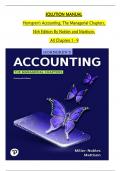SOLUTION MANUAL
Horngren's Accounting, The Managerial Chapters,
14th Edition By Nobles and Mattison,
All Chapters 1 - 9
,Table of contents
1. Introduction to Managerial Accounting
2. Job Order Costing
3. Process Costing
4. Cost-Volume-Profit Analysis
5. Master Budgets
6. Flexible Budgets and Standard Cost Systems
7. Cost Allocation and Responsibility Accounting
8. Short-Term Business Decisions
9. Capital Investment Decisions
,Chapter M:1
Introduction to Managerial Accounting
Review Questions
1. What is the primary purpose of managerial accounting?
The primary purpose of managerial accounting is to provide information to help
managers plan, direct, control, and make decisions.
2. List six differences between financial accounting and managerial accounting.
Financial accounting and managerial accounting differ on the following 6 dimensions: (1)
primary users, (2) purpose of information, (3) focus and time dimension of the information,
(4) rules and re- strictions, (5) scope of information, and (6) behavioral.
3. Explain the difference between line positions and staff positions.
Line positions are directly involved in providing goods or services to customers. Staff
positions support line positions.
4. Explain the differences between planning, directing, and controlling.
Planning means choosing goals and deciding how to achieve them. Directing involves
running the day-to-day operations of a business. Controlling is the process of monitoring
operations and keeping the company on track.
5. List the four IMA standards of ethical practice and briefly describe each.
The four IMA standards of ethical practice and a description of each follow.
I. Competence.
Maintain an appropriate level of professional leadership and expertise by
enhancing knowledge and skills.
Perform professional duties in accordance with relevant laws, regulations, and
technical standards.
Provide decision support information and recommendations that are accurate, clear,
concise,
, and timely.
Recognise and help mange risk.
II. Confidentiality.
Keep information confidential except when disclosure is authorized or legally required.
Inform all relevant parties regarding appropriate use of confidential information.
Monitor to ensure compliance.
Refrain from using confidential information for unethical or illegal advantage.
III. Integrity.
Mitigate actual conflicts of interest. Regularly communicate with business associates to
avoid apparent conflicts of interest. Advise all parties of any potential conflicts.
Refrain from engaging in any conduct that would prejudice carrying out duties ethically.
Abstain from engaging in or supporting any activity that might discredit the profession.
Contribute to a positive ethical culture and place integrity of the profession above
personal interest.
5, cont.
IV. Credibility.
Communicate information fairly and objectively.
Provide all relevant information that could reasonably be expected to influence an
intended user’s understanding of the reports, analyses, or recommendations.
Report any delays or deficiencies in information, timeliness, processing, or internal
controls in conformance with organization policy and/or applicable law.
Communicate any professional limitations or other constraints that would preclude
responsi- ble judgment or successful performance of an activity.
6. Describe a service company and give an example.
Service companies sell time, skills, and knowledge. Examples of service companies include
phone service companies, banks, cleaning service companies, accounting firms, law firms,
medical physi- cians, and online auction services.
7. Describe a merchandising company and give an example.
Merchandising companies resell products they buy from suppliers. Merchandisers keep an
inventory of products, and managers are accountable for the purchasing, storage, and sale of
the products. Ex- amples of merchandising companies include toy stores, grocery stores, and
clothing stores.
8. How do manufacturing companies differ from merchandising companies?
Merchandising companies resell products they previously bought from suppliers, whereas
manufac- turing companies use labor, equipment, supplies, and facilities to convert raw




